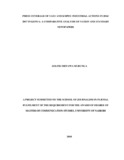| dc.description.abstract | This study sought to explore the print media’s coverage of industrial disputes by medical practitioners and university academic teaching staff in Kenya. Specifically, it comparatively examined patterns of coverage before, during and after the 2016/2017 industrial actions by the Daily Nation and Standard newspapers. It also explored key issues in the two industrial disputes that came out in the press during the coverage. Additionally, the study investigated the views held by stakeholders pertaining press coverage of the two disputes and what needs to be done to improve the coverage of industrial disputes by the print media in Kenya. The study relied on agenda building theory, which has attributes of priming and framing. It utilised mixed methods approach and non-probability sampling technique where purposive sampling guided the research. Interviewer-guided questionnaires were used for the quantitative data while interviews were used for qualitative data. The content analysis was used to examine the content of the two editions published between November 2016 and December 2017, while key informants were interviewed to triangulate the results. The findings of the study revealed that coverage was subtle before the two industrial actions, then peaked during the industrial actions and were low after the industrial actions. Findings reveal that medical practitioners’ industrial action was given more prominence than the dons’ industrial action. Results reveal that the dominant discourses were consequences of the industrial actions, dynamics of the industrial actions, prevention of industrial actions and negotiations at the time of coverage. Results also showed that the Daily Nation did a better coverage of the disputes than The Standard. Results show that most of the factors influencing editors and reporters in their coverage of labour disputes corresponded with newsroom pressure, news sources, news values and editorial policies. Lastly, findings reveal that stakeholders outside the media felt the media did not do enough in efforts to cover the two disputes. In conclusion, mass media rely on information outside the press in construction of the media agenda and the media follows up on available and reliable sources depending on set guidelines to produce the news. The study recommends a multi-sectoral approach to end of perennial strikes in the public service. There are critical areas of research as follow-up to this study. | en_US |



